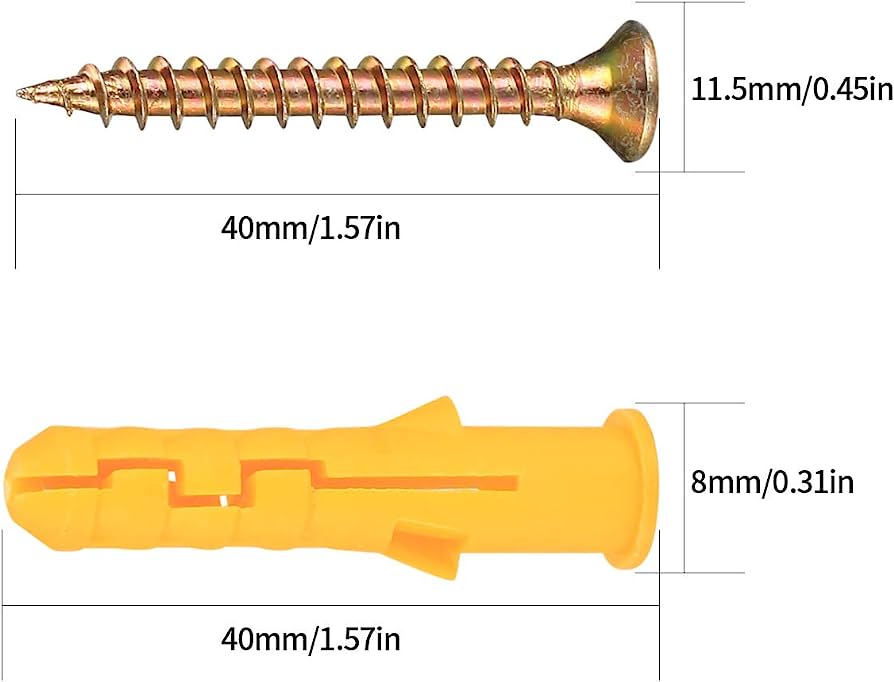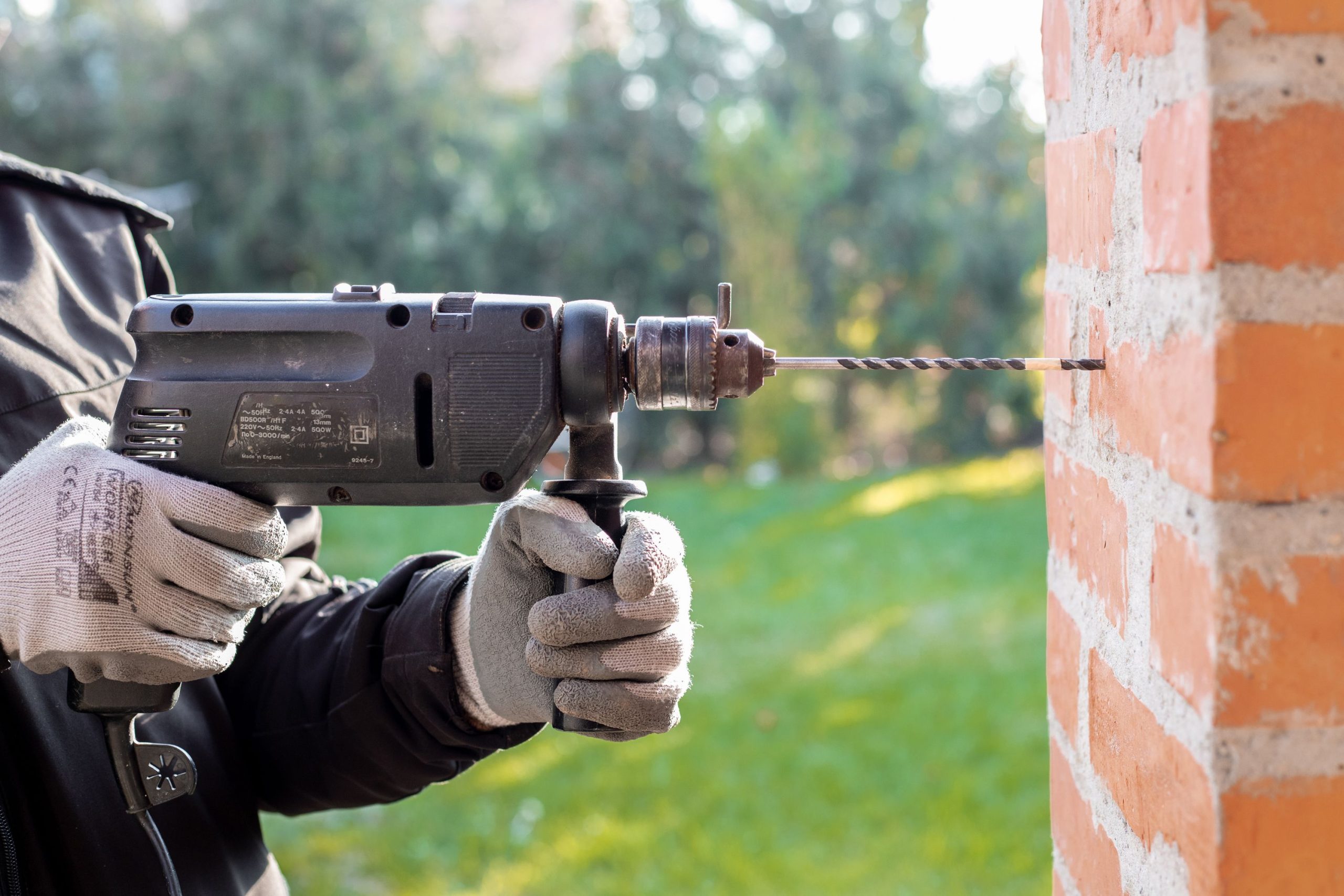When embarking on a do-it-yourself venture involving brick walls, one might be tempted to utilize any screws lying around in the garage. While it would be convenient to deplete the remnants of screws from a previous home improvement project, the repercussions for your brick wall could be disastrous.
Using incorrect screws in brick can lead to harm and necessitate additional work in the future. It could also render the incompatible screws useless for subsequent projects.
To evade an unfavorable outcome in your home improvement endeavor involving a brick wall or other brick surfaces, adhere to the ensuing guidance and steps as we address the query, “What type of screws should be employed in bricks?” and more.
Appropriate Screw Selection for Bricks

Screws with self-tapping capability accompanied by plastic plugs.
In case of uncertainty about the screws suitable for a particular undertaking, it is advisable to conduct some research before delving into the project or embarking on a trip to the hardware store.
Most enthusiasts of do-it-yourself projects and professionals in the field of home improvement recommend employing concrete screws meticulously crafted with the distinctive attributes of brick and similar materials in mind, such as screws intended for bricks.
As concretefasteners.com emphasizes, “Self-tapping brick anchors, concrete block or concrete screws are used for fastening items to brick. Concrete screws are most commonly called Tapcon masonry screws. The heavy-duty masonry screw possesses the versatility for use in brick, mortar joints, CMU, block or solid concrete.” If, by chance, you possess self-tapping brick anchors, concrete block or concrete screws in your toolbox or garage, you are welcome to employ them.
If not, it might be necessary to visit the hardware store and ensure that the screws you select fall into one of those categories. If you remain uncertain, you can always seek guidance from an experienced handyman prior to proceeding to the checkout counter.
How to Insert Self-Tapping Screws?
With a name like “self-tapping screws,” one might assume that the screws can simply be extracted from their packaging, positioned near the wall, and witness them magically burrow themselves into it.
Although it would be a delightful attribute (if anyone invents such screws, please notify us as we would also be interested!), the term “self-tapping” is somewhat misleading. Self-tapping screws function by creating and cutting threads.
This implies that as the self-tapping screws are driven into the material, they spiral and incise the material.
While this process can pose complications if the screws are excessively tightened and lead to material damage, it is advantageous because, in most cases, it eliminates the necessity of drilling a pilot hole. Nevertheless, if you feel more comfortable initiating with a pilot hole, it won’t cause any harm.
Since brick can be surprisingly delicate, prone to breakage and chipping, particularly if aged or crumbling, it is preferable to minimize interference during the drilling process. Consequently, drilling a pilot hole can complicate matters and result in damage to the surrounding brick.
The insertion of a self-tapping screw is a relatively straightforward process. As detailed in an article by howstuffworks.com, “Self-tapping screws can be inserted using either a hand-held or electric screwdriver.
Before utilizing self-tapping screws, it is beneficial, although not mandatory, to create a pilot hole through the material. This ensures easy insertion and proper positioning of the screw. Ensure that the drill bit used for the pilot hole is smaller than the self-tapping screw itself.
Otherwise, if the hole is too large, the screw threads will lack a surface to grip onto. Next, align the screw properly and secure it in place using either a flat head or Phillips screwdriver, depending on the type of screw head.
If the screw is inserted at an angle, it may result in a stripped head. Lastly, tighten the screw until it can no longer be turned easily, taking care not to over-tighten and risk stripping the threads.”
Is it Possible to Screw Directly into Brick?
Unfortunately, screwing directly into brick is generally not recommended. Consequently, it is advisable to allocate extra time to prepare the brick before attaching screws. Various preparations can be undertaken to ensure the brick is ready for screw insertion.
As stated by homebuilding.co.uk, “For novice DIYers, it is crucial to understand that screws cannot be directly screwed into brick. You need to drill a hole, insert a rawl plug (a type of fixing that keeps the screw secure), and then screw into it.
This process is simpler when dealing with a brick wall compared to plasterboard, which might necessitate specialized fixings.”
If time is of the essence, it might be prudent to postpone the project to a later date to ensure that you can devote adequate care and attention to prevent the brick in your wall from crumbling or sustaining damage.
Fortunately, the preparation required for screwing into brick does not need to be excessively time-consuming. With the aid of an electric drill, drilling the initial hole should only take a few seconds. Similarly, inserting a rawl plug is a swift process.
Once the preparatory work is complete, you can proceed to affixing a screw suitable for concrete, masonry, brick, or comparable materials. At this point, you are ready to hang your cherished artwork or install any desired decor or items on your wall.
What Type of Drill is Needed for Bricks?

When drilling holes, it is natural to assume that any drill available on the market (or in your garage) can accomplish the task. Although certain drills may function adequately with various materials, the most suitable option for drilling into brick is a specific drill known as a “hammer drill.”
A hammer drill is designed to emulate the motion of a hammer by incorporating a combination of hammering and rotary drilling actions. This amalgamation allows the hammer drill to penetrate hard, brittle materials.
Failure to use a hammer drill may result in wall damage. Furthermore, your tool might be subjected to harm, rendering it unsuitable for subsequent projects on your do-it-yourself agenda. To value your time, tools, and surfaces, it is crucial to invest in the appropriate equipment.
After all, using an unsuitable drill on brick would necessitate a visit to the hardware store shortly afterward to obtain a replacement drill. It is advisable to get it right the first time to avoid purchasing two drills during your next trip to the hardware shop.
Do Masonry Screws Require Wall Plugs?

Regrettably, regular screws are unable to securely fasten into masonry, plasterboard, or similar materials without the assistance of wall plugs. Wall plugs serve the purpose of filling the excess space within the drilled hole.
By firmly gripping the edges of the hole, they aid in keeping the screw securely in place. An additional advantage of wall plugs is that they maintain the screw’s position without inflicting additional wear, tear, or damage to the walls.
